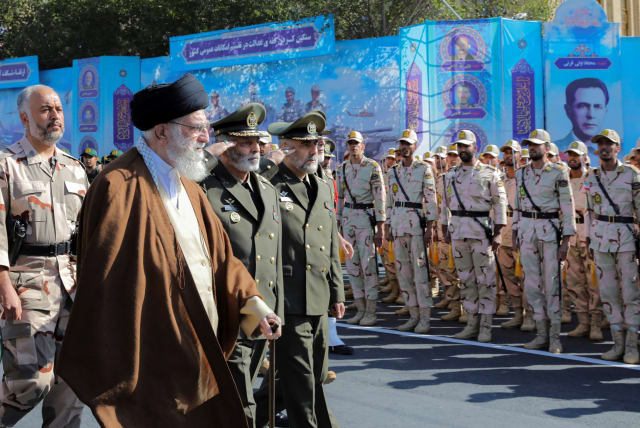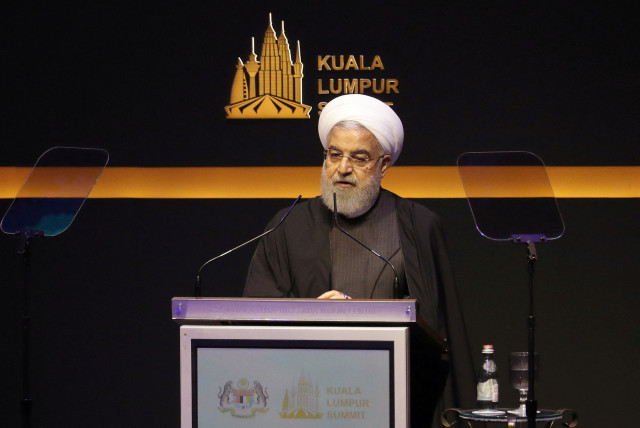Iran is with child: Predicting the future of the Islamic Republic - opinion

One way to read Iran’s political tea leaves is through candidate disqualifications. That way, it can be seen what the future may have in store for the Islamic Republic.
Election results in Iran rarely produce real surprises as they are a kabuki dance forced on the people to choose from a pre-dictated list of bad versus worse candidates.
Much like in the Soviet era, when the standing order of politburo officials at public events in Moscow hinted at who was in or out of favor, one way to read Iran’s political tea leaves is through candidate disqualifications.
Just last week, Iran’s former president Hassan Rouhani pre-empted the news of his candidacy disqualification by Iran's Guardian Council for the forthcoming Assembly of Experts elections on March 1, 2024.
Rouhani's announcement before its formal declaration may have been a proactive move to put public pressure on Iran’s Supreme Leader Ali Khamenei hoping to avert his disqualification.
The pivotal task of the Assembly of Experts is to select Iran’s single most powerful person, the supreme leader. Thus, if Rouhani is indeed disqualified, it is thought to solidify the influence of the fundamentalist wing of the clerical regime, currently empowered by the Islamic Revolutionary Guards Corps (IRGC).
That wing, which offers a religious façade to the powerful IRGC, is most visible among the entourage of current President Ebrahim Raisi, regarded by Iranians as heading the least competent government in the past half a century.
Political camps in Iran, in addition to their ideological brand, are also labeled in terms of their foreign policy gravitations. For example, because of its close ties to Beijing and Moscow, the Raisi team is viewed as the "Chinese" and "Russian" camp. Rouhani, on the other hand, having favored rapprochement with the British and Americans, is seen as Western inclined.
Over the years, such branding has directly affected when, where, and how an opposing camp has undermined critical foreign policy initiatives, explaining why Iran’s foreign policy under the clerics has consistently taken one step forward and two steps back.
Global Implications
Given the continued rumors about the ill-health of the octogenarian supreme leader, serious jockeying for his successor has galvanized the various political camps in Iran, as it will deliver absolute (divine) power to whichever camp consolidates the balance of power in Iran’s Assembly of Experts. And so, the effects of Rouhani’s disqualification may have consequences far beyond personal political rivalries within the Islamic Republic. It can directly influence the balance of global polar power in the Middle East and beyond — through the redefinition of spheres of influence between NATO / EU States, Moscow, and Beijing.
While Rouhani's disqualification will offer a critical short-term tactical win for Raisi's inner circle and extend his influential base around Khamenei and the IRGC, the key question will be how much Rouhani’s losing camp is sidelined.
Will Rouhani be threatened into silence, much like after the sidelining of former presidents Rafsanjani, Ahmadinejad, and Khatami? Or will his camp be able to vocalize a pseudo-opposition to a new generation of ideologues climbing the ranks of power through Raisi’s robe-tail?
Either outcome will boldly highlight the conflicting contrast between the clerical regime— turning more ideological and openly reliant on the IRGC — and the Iranian people, whose message of Woman, Life, and Freedom was a regime change declaration captured by the still simmering Jina Mahsa Amini revolutionary movement.
Achilles Heel
Internally, the Iranian regime is vividly aware of its mounting challenges, from power struggles among its political fractions to the very real revolutionary fever dominating its streets and citizenry.
The Hamas attack on Israel, whether directed by Tehran or not, forced the Iranian regime to project its regional power and thus, for now, keep its proxies at bay. The conflict also allowed it to divert attention from its domestic issues.
However, unless the Hamas war expands into a broader conflict, the regime’s Achilles heel remains rooted within Iran itself: The Iranian people’s quest to find a way out of the darkest social, political, and economic despair since 1979.
The social unrest in Iran has deep roots in the lack of economic opportunity, massive corruption, mismanagement, and incompetence by the regime, topped by an iron fist. The clerical regime in Iran has failed in every measurable social, political, and especially economic category, including a 500% devaluation of Iran’s national currency, the rial, and a decade-long economic growth rate of zero.
And so, the world has the most consequential and powerful ally in the Iranian people, who face imprisonment, torture, and daily executions, all for demanding a better life.
Well before October 7, the Iranian people rarely missed an opportunity to daringly shout: “Not Gaza, not Lebanon, I give my life only for Iran.” This profound slogan has been a daring rejection of the regime’s regional adventurism. It has been a rejection of billions of US dollars squandered on Hamas, Hezbollah, and the Houthis while Iranians struggle to make ends meet and feed their families.
After October 7, Iranians dared to express sympathy and support for the people of Israel. As documented by the Anti-Defamation League (ADL) in 2014, Iranian people are the least antisemite people in the region, if not the world. This fact would be remarkable, given the Iranian regime’s 45 years of daily antisemitic propaganda. Still, it is not: The Persian and Jewish civilizations not only have biblical ties, but Persian Jews have continuously lived on the Persian plateau for at least one millennium before the birth of Islam.
Equally relevant is the perception of the majority of Iranian people about the West. Once again, in contrast to the Iranian Regime’s restless propaganda, the Iranian people, who are among the region’s best-educated and most progressive, have always had a strong affinity towards the West. Even the regime’s princelings, former officials, diplomats, and even clerics choose the West (Europe, Canada, and the US) to live in if they can!
Nursing a Pregnancy
Today, Iran is pregnant with child, and that child is its people’s quest for freedom from Islamist rule.
In response to last year’s Mahsa uprising, western open societies offered valuable tactical moral support for the Iranian people. By awarding the Nobel Peace Prize to Iran’s brave Narges Mohammadi and then the European Parliament’s Sakharov Prize to Jina Mahsa Amini, whose murder triggered the Mahsa revolution, the free world offered valuable tactical moral support for the courage of the Iranian people.
However, beyond symbolic tactical support by world democracies, what the people of Iran most need is a strategic commitment and support for their revolutionary movement. They expect an investment, not in war, but in their quest and aspiration for freedom and secularism.
The Islamist regime’s biggest strength – outside of its borders with its proxies – is its narrative of Shi’a militancy. On the opposing front, the Iranian people offer a more powerful narrative: That Islamist rule has failed. That culture, humanity, individual freedom, and opportunity are the cornerstones of free enterprise, commerce, and regional peace.
Today, the free world has an exceptional opportunity to choose between which paradigm to align itself with: The Iranian regime, its militancy, and its endless dance of diplomatic kabuki, or the very real vision the Iranian people have for a future Iran.
Mehrdad Marty Youssefiani is an Iranian-American member of the board of fellows at the Jerusalem Center for Public Affairs. He previously, served as a senior strategic counselor to Iran’s former crown prince. Damon Golriz is an Iranian-Dutch lecturer at The Hague University of Applied Sciences and a research fellow on International Peace, Justice, and Security.
Jerusalem Post Store
`; document.getElementById("linkPremium").innerHTML = cont; var divWithLink = document.getElementById("premium-link"); if (divWithLink !== null && divWithLink !== 'undefined') { divWithLink.style.border = "solid 1px #cb0f3e"; divWithLink.style.textAlign = "center"; divWithLink.style.marginBottom = "15px"; divWithLink.style.marginTop = "15px"; divWithLink.style.width = "100%"; divWithLink.style.backgroundColor = "#122952"; divWithLink.style.color = "#ffffff"; divWithLink.style.lineHeight = "1.5"; } } (function (v, i) { });

